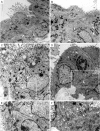Matrilysin (matrix metalloproteinase-7) mediates E-cadherin ectodomain shedding in injured lung epithelium
- PMID: 12759241
- PMCID: PMC1868120
- DOI: 10.1016/S0002-9440(10)64318-0
Matrilysin (matrix metalloproteinase-7) mediates E-cadherin ectodomain shedding in injured lung epithelium
Abstract
Matrilysin (matrix metalloproteinase-7) is highly expressed in lungs of patients with pulmonary fibrosis and other conditions associated with airway and alveolar injury. Although matrilysin is required for closure of epithelial wounds ex vivo, the mechanism of its action in repair is unknown. We demonstrate that matrilysin mediates shedding of E-cadherin ectodomain from injured lung epithelium both in vitro and in vivo. In alveolar-like epithelial cells, transfection of activated matrilysin resulted in shedding of E-cadherin and accelerated cell migration. In vivo, matrilysin co-localized with E-cadherin at the basolateral surfaces of migrating tracheal epithelium, and the reorganization of cell-cell junctions seen in wild-type injured tissue was absent in matrilysin-null samples. E-cadherin ectodomain was shed into the bronchoalveolar lavage fluid of bleomycin-injured wild-type mice, but was not shed in matrilysin-null mice. These findings identify E-cadherin as a novel substrate for matrilysin and indicate that shedding of E-cadherin ectodomain is required for epithelial repair.
Figures









Similar articles
-
Matrilysin expression and function in airway epithelium.J Clin Invest. 1998 Oct 1;102(7):1321-31. doi: 10.1172/JCI1516. J Clin Invest. 1998. PMID: 9769324 Free PMC article.
-
Matrilysin (Matrix Metalloproteinase-7) regulates anti-inflammatory and antifibrotic pulmonary dendritic cells that express CD103 (alpha(E)beta(7)-integrin).Am J Pathol. 2009 Dec;175(6):2319-31. doi: 10.2353/ajpath.2009.090101. Epub 2009 Nov 5. Am J Pathol. 2009. PMID: 19893044 Free PMC article.
-
Matrilysin mediates extracellular cleavage of E-cadherin from prostate cancer cells: a key mechanism in hepatocyte growth factor/scatter factor-induced cell-cell dissociation and in vitro invasion.Clin Cancer Res. 2001 Oct;7(10):3289-97. Clin Cancer Res. 2001. PMID: 11595727
-
Role of matrix metalloproteinase-7 (matrilysin) in human cancer invasion, apoptosis, growth, and angiogenesis.Exp Biol Med (Maywood). 2006 Jan;231(1):20-7. doi: 10.1177/153537020623100103. Exp Biol Med (Maywood). 2006. PMID: 16380641 Review.
-
Matrix metalloproteinases in lung repair.Eur Respir J Suppl. 2003 Sep;44:36s-38s. doi: 10.1183/09031936.03.00001203. Eur Respir J Suppl. 2003. PMID: 14582900 Review. No abstract available.
Cited by
-
The Many Faces of Matrix Metalloproteinase-7 in Kidney Diseases.Biomolecules. 2020 Jun 25;10(6):960. doi: 10.3390/biom10060960. Biomolecules. 2020. PMID: 32630493 Free PMC article. Review.
-
Matrix metalloproteinase-7 coordinates airway epithelial injury response and differentiation of ciliated cells.Am J Respir Cell Mol Biol. 2013 Mar;48(3):390-6. doi: 10.1165/rcmb.2012-0083OC. Epub 2012 Dec 20. Am J Respir Cell Mol Biol. 2013. PMID: 23258229 Free PMC article.
-
Individual matrix metalloproteinases control distinct transcriptional responses in airway epithelial cells infected with Pseudomonas aeruginosa.Infect Immun. 2007 Dec;75(12):5640-50. doi: 10.1128/IAI.00799-07. Epub 2007 Oct 8. Infect Immun. 2007. PMID: 17923522 Free PMC article.
-
Meeting report on the 12th International Congress of Histochemistry and Cytochemistry (ICHC).J Cell Physiol. 2005 Aug;204(2):407-11. doi: 10.1002/jcp.20418. J Cell Physiol. 2005. PMID: 15895396 Free PMC article.
-
MMP1 and MMP7 as potential peripheral blood biomarkers in idiopathic pulmonary fibrosis.PLoS Med. 2008 Apr 29;5(4):e93. doi: 10.1371/journal.pmed.0050093. PLoS Med. 2008. PMID: 18447576 Free PMC article.
References
-
- Laitinen LA, Heino M, Laitinin A, Kava T, Haahtela T: Damage of the airway epithelium and bronchial reactivity in patients with asthma. Am Rev Respir Dis 1985, 131:599-606 - PubMed
-
- Jeffery PK, Wardlaw AJ, Nelson FC, Collins JV, Kay AB: Bronchial biopsies in asthma. An ultrastructural, quantitative study and correlation with hyperreactivity. Am Rev Respir Dis 1989, 140:1745-1753 - PubMed
Publication types
MeSH terms
Substances
Grants and funding
LinkOut - more resources
Full Text Sources
Other Literature Sources

